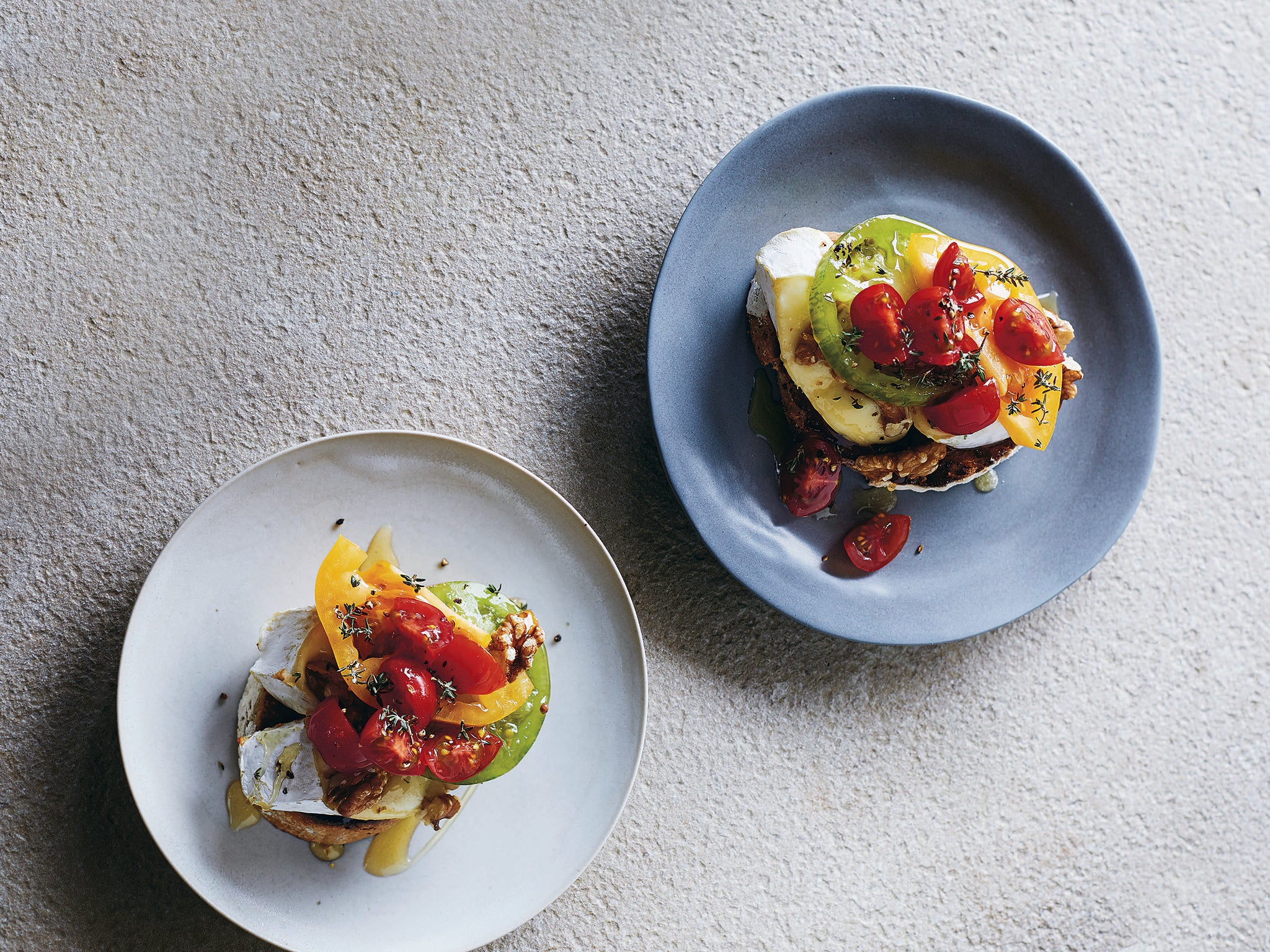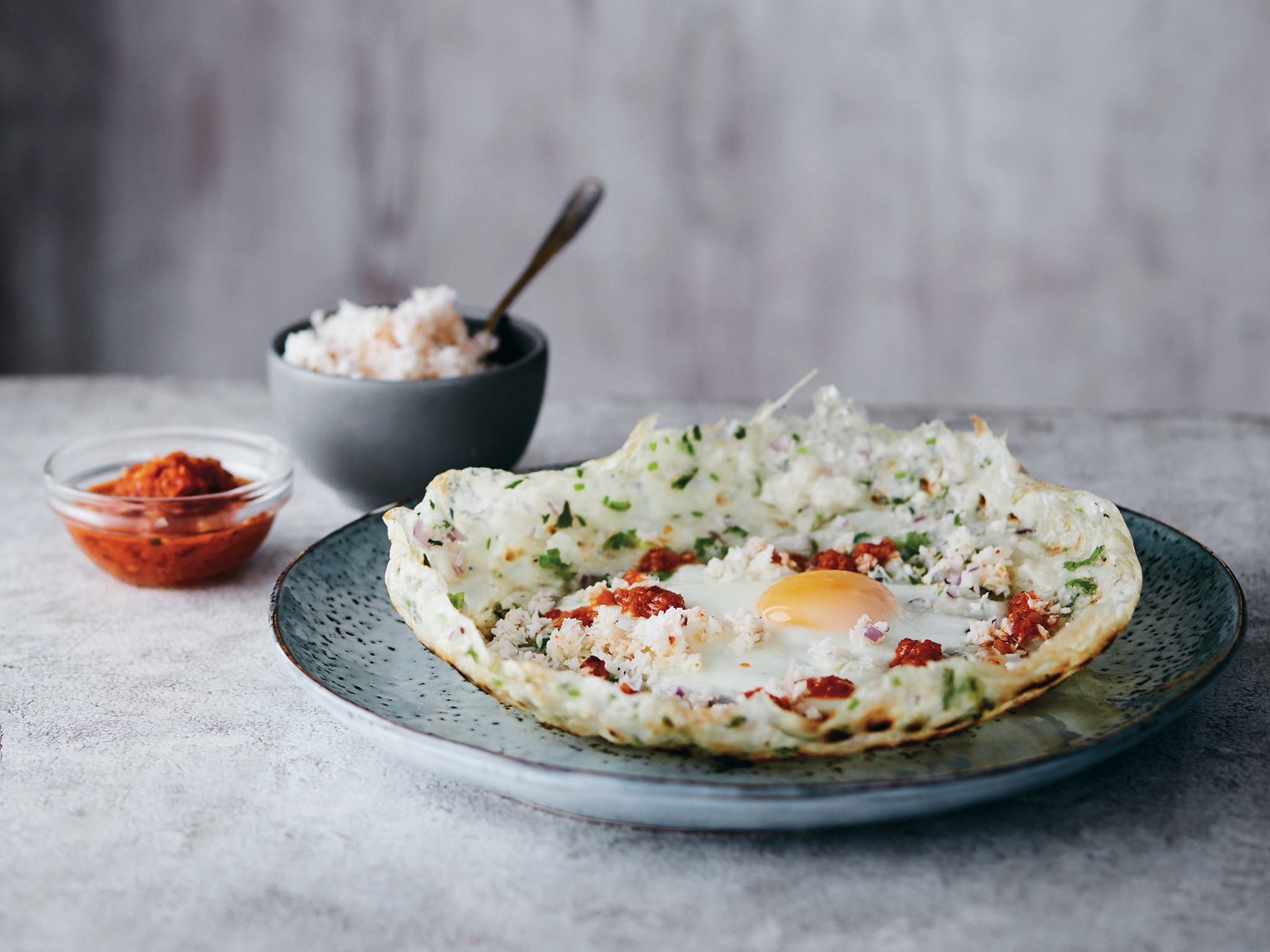‘New Kitchen Basics’ cookbook.
Fried halloumi with aubergine and butter beans
Halloumi is often the default cheesy slab to fry or grill (broil). Served as a meaty substitute at a barbecue, like it so often is, it can lack any real interest, save its characteristic squeaky saltiness. Halloumi can also tend to dry out when cooked. As a result, I think it is essential to serve halloumi alongside something full-tasting and unctuous; something that has a bit of moisture to it. Tomatoes and aubergine (eggplant), cooked with honey and paprika, make this dish just the ticket. Serve with pita or flatbreads to mop up the dish.
4 tablespoons olive oil, plus extra to finish and serve
4 cloves of garlic, peeled and finely chopped
1 x 400g (14oz) can of whole plum tomatoes or 400g (14oz) fresh tomatoes
2 teaspoons ground cumin
2 teaspoons sweet paprika (not smoked)
1⁄2 teaspoon chilli flakes
1 teaspoon salt, plus extra to season
1 tablespoon runny honey
2 large aubergines (eggplants), peeled and finely diced
2 x 400g (14oz) cans of butter (lima) beans, drained and rinsed
Zest and juice of 1⁄2 unwaxed lemon
Small bunch of flat-leaf parsley, leaves picked and finely chopped, plus extra to serve
450g (1lb) halloumi, cut into 1cm (1⁄2in) slices
Pita or flatbreads
Freshly ground black pepper, to serve
4 cloves of garlic, peeled and finely chopped
1 x 400g (14oz) can of whole plum tomatoes or 400g (14oz) fresh tomatoes
2 teaspoons ground cumin
2 teaspoons sweet paprika (not smoked)
1⁄2 teaspoon chilli flakes
1 teaspoon salt, plus extra to season
1 tablespoon runny honey
2 large aubergines (eggplants), peeled and finely diced
2 x 400g (14oz) cans of butter (lima) beans, drained and rinsed
Zest and juice of 1⁄2 unwaxed lemon
Small bunch of flat-leaf parsley, leaves picked and finely chopped, plus extra to serve
450g (1lb) halloumi, cut into 1cm (1⁄2in) slices
Pita or flatbreads
Freshly ground black pepper, to serve
Put three tablespoons of olive oil in a pan over a moderate heat. Add the garlic and fry for about 30 seconds, then add the tomatoes, spices, salt and honey, and cook for two minutes until starting to thicken.
Tomato and brie toast with honey and walnuts
Cheese on toast; tomatoes too. A predictably delicious combination. It’s the sort of simple recipe that gives cookbooks bad press. Easy to assemble, this cheese on toast is unforgettable and more than worthy of the name new kitchen basic.
4 slices of bread (sourdough or ciabatta is good here), toasted
30g (1oz) unsalted butter
250g (9oz) ripe brie cut into smaller pieces
50g (13⁄4oz) shelled walnuts, roughly chopped
1 tablespoon thyme leaves
400g (14oz) ripe tomatoes, thickly sliced or diced as you like
2 tablespoons runny honey
Salt and freshly ground black pepper
30g (1oz) unsalted butter
250g (9oz) ripe brie cut into smaller pieces
50g (13⁄4oz) shelled walnuts, roughly chopped
1 tablespoon thyme leaves
400g (14oz) ripe tomatoes, thickly sliced or diced as you like
2 tablespoons runny honey
Salt and freshly ground black pepper
Preheat the oven to 180C/fan/160C/350F/Gas 4. Butter the toasted slices of bread and place the slices on a baking sheet. Evenly distribute the brie, walnuts and half the thyme onto each slice of toast. Bake in the hot oven for two to three minutes, until the brie begins to melt a little and the walnuts start to toast.
Remove the toast from the oven and top with the tomatoes. Season with salt and pepper, drizzle with the honey and the remaining thyme and serve immediately.
Coconut, red onion and green chilli hoppers with two sambals .
Coconut pancakes fried with an egg, called hoppers, are a Sri Lankan breakfast staple. Served with two sambals – one paste is fine and fresh; one feathery with coconut – this is a breakfast or brunch to master, and make again and again. Work quickly to shape the pancake, using a high-sided frying pan or a wok for a traditional lipped hopper. Rice flour is best, but you can get away with using plain (all-purpose) flour.
150g (5oz) rice flour or 100g (3½oz) plain (all-purpose) flour
200ml (7oz) warm water
1 teaspoon fast-action dried yeast
11⁄2 teaspoons caster (super fine) sugar
1⁄2 teaspoon salt, plus extra to season
100g (3½oz) desiccated (shredded) coconut
200ml (7oz) boiling water
1 red onion, peeled and very finely diced
4 teaspoons chilli flakes
Juice of 1 lime
2 teaspoons fish sauce (optional but pretty good)
1-2 green chillies, finely chopped (remove the seeds if you want less heat)
4 tablespoons finely chopped coriander (cilantro) or mint
4 eggs
Vegetable oil
200ml (7oz) warm water
1 teaspoon fast-action dried yeast
11⁄2 teaspoons caster (super fine) sugar
1⁄2 teaspoon salt, plus extra to season
100g (3½oz) desiccated (shredded) coconut
200ml (7oz) boiling water
1 red onion, peeled and very finely diced
4 teaspoons chilli flakes
Juice of 1 lime
2 teaspoons fish sauce (optional but pretty good)
1-2 green chillies, finely chopped (remove the seeds if you want less heat)
4 tablespoons finely chopped coriander (cilantro) or mint
4 eggs
Vegetable oil
First, make the batter. Mix the flour with the warm water, yeast, half a teaspoon of the sugar and the salt. Leave to one side for about 30 minutes to start to bubble.
Meanwhile, put the desiccated (shredded) coconut into a heatproof bowl and pour over the boiling water.
To make the second sambal, mix half the soaked coconut with one teaspoon of sugar, one teaspoon of chilli flakes, another big pinch of salt, two tablespoons of the remaining diced red onion and the remaining lime juice. Put into a bowl and set aside. To make the first sambal, put half the red onion with three teaspoons of the chilli flakes in a pestle and mortar and pound (or give them a quick pulse in a food processor, if you prefer) to a coarse paste. Put the mixture in a bowl and mix with half the lime juice and the fish sauce (if using), and a big pinch of salt to season. Put into a serving dish and set aside.
When the batter is bubbly, mix in the remaining diced red onion, the green chilli, the remaining soaked coconut and the herbs. Break one egg into a cup and have it ready to add to the pancake.
Heat a non-stick frying pan over a moderate heat and rub with a thin film of oil. Pour a ladleful of the batter into the pan, tilting it so the batter begins to cook up the edges of the pan in a thin layer. Quickly add the egg into the centre of the pancake and cover with a lid. Leave to cook for about two to three minutes until the egg is just cooked and the edges of the pancake are starting to colour.
Run a flexible spatula or palette knife around the edges of the pan and slide the hopper onto a plate. Repeat with the remaining batter and eggs. Serve immediately with generous helpings of the two sambals.






No comments